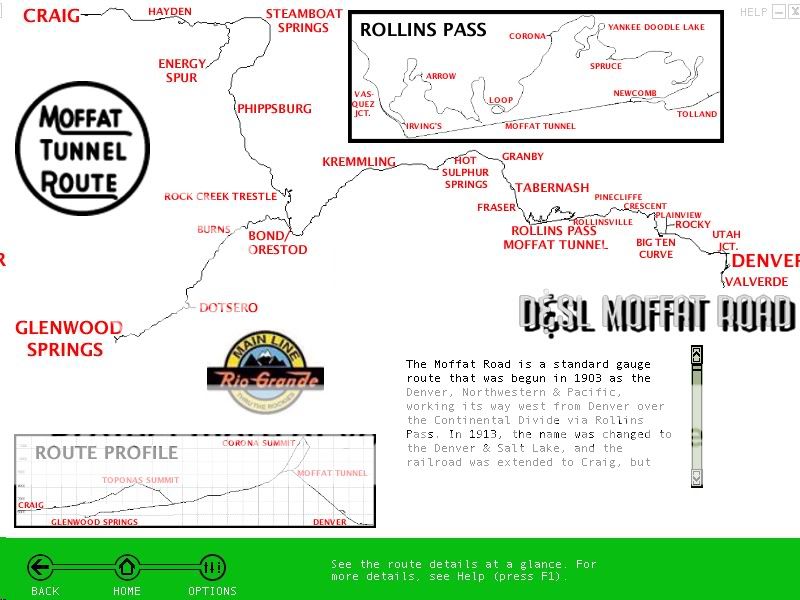 |
If one looks at much of the line, it is about moving traffic. The typical arrangement on the western side is for there to be a geographic obstacle such as a canyon, followed by a passing siding, a trip across a mountain park to the local major town (with a siding) followed by the rest of the trip across the mountain park and another passing siding right before the next obstacle. It is easy to see how this could be easily compressed to an obstacle-siding/town-obstacle format. On the eastern side, this is already the case, with the exception that the towns are typically more a collection of a few houses.
Yet, there is also some local traffic, particularly out of Denver. Denver connects to the Belt line, which can support as many as five local switching jobs to the North and East of Denver. An additional switching job runs to South Denver, and there are transfer runs to the recently closed Burnham Shops, and the central Denver industries. There used to be a run to the Association Line in West Denver (now the route of a Light Rail line), and the Rocky Local which runs out to a branch at the base of the foothills. There are some industries along the line as it heads west out of Denver, but the line is also shared with traffic to the BNSF Golden Branch which primarily sees Beer Trains to Coors Brewery in Golden.
But all of these are on the east end of the line. East of the Moffat Tunnel, once you are past Rocky Siding where the Rocky Flats branch leaves, there is almost nothing. Plain siding seems to occasionally get some supply cars for MOW crews working up the line. Pinecliffe appears to have the remains of a team track which could be restored in the model to provide a little traffic. Rollinsville also appears to have a team track arrangement, and there is definitely some activity at East Portal, including a large building with two tracks running into it which I have not been able to find its purpose. Anyone know?
West of the tunnel, things get a little better but not much. There are a few spurs in Fraser, Granby, Tabernash, and Kremmling, but really very little. Consequently, once you are west of Denver, past Rocky siding, almost all of the trains are through trains. This makes the vast majority of the route a dispatcher's railroad. The engineer's portion is really focused between Denver and Rocky, and then there are really only switching jobs outside of the yard if this area is given the space to be modeled. Now, I like the Dispatcher aspect, and the line is complicated with the use of Swing Helpers. Often helpers are added at Bond or Tabernash to Eastbounds, and run with the train to Denver. Trains out of Denver get helpers that run the opposite route. There are not many helpers that are cut off and return to either location. In addition, you can have passenger traffic, as the line hosts Amtrak, the Skit Train, and various excursions such as the American Orient Express.
There is a lot going for this route - and that is obvious when you look at some of the existing model railroads of this route. Brian Holtz had the Panaramic Division in Model Railroader in the 1980s, Doug Tagsold modeled this route, eventually giving even more layout space to the Denver Belt Line than he had originally, and then there is Mike Danneman's Moffat Route, which is an artistic masterpiece. If you have not seen it, you have not been paying attention as it has made both Model Railroader and is a regular in N-Scale Railroading.

Video Slide Show of Mike Danneman's Layout
You have to see his layout in person to believe it. It is artistic beauty. I've been inspired by it since the original planning article in NSR (Issue #5 May/June 2001). I love Mike's layout and his talent, but he models 5 of the 9 sidings between Denver and the Moffat Tunnel's East Portal. Consequently, the operations potential for locals out of Denver is limited. I have to wonder if I can do better in my space? Can I get even some of the spectacular scenery without sacrificing as much operations potential as I think Mike had to in his space? Furthermore, knowing Mike's spectacular layout is out there, anything I do would get compared to it, and would that bother me? I've met Mike personally, and think the world of his talent, both in the model world, but also in the photography world. He is well worth following on Flicker under the handle Moffat Road. So, is this the route to take with my modeling...there are lots of good reasons to go down this track...
Until next time...





No comments:
Post a Comment